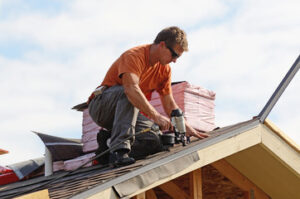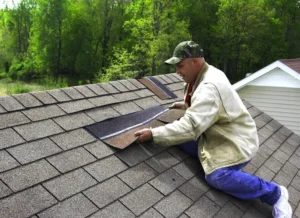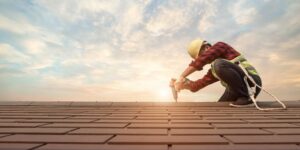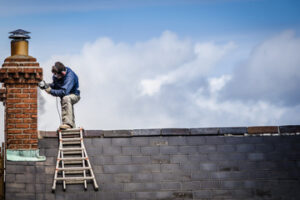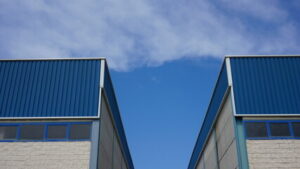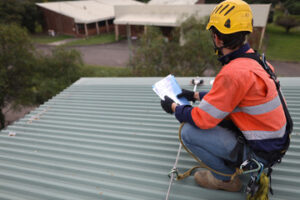Unlike a fresh coat of paint, a new roof offers an opportunity to fix the entire house’s problems. Fortunately, Roofers Cape Coral are fairly straightforward and inexpensive.
Start by entering the attic or crawl space and looking for damp spots. Black marks, mold, sagging beams—those are red flags.

If your roof has suffered damage from a severe wind event, it’s important to have the broken shingles replaced promptly to avoid further damage to your home. Your homeowner’s insurance will often cover the cost of replacing these shingles. If you’re not confident in your ability to replace shingles, you should hire a professional roofing contractor to handle the repairs.
Start by accessing the area of your roof where you wish to repair a damaged shingle. It’s important to use a safe ladder and secure it well at the base before climbing up on the roof. Then, carefully evaluate the damage. Look for raised shingles, particularly around the edges of your roof. Lifted shingles can allow moisture to penetrate the roof deck and cause leaks or even rot.
Using a pry bar, loosen the shingles above the shingle you wish to remove. Pull up the tabs of the shingle to reveal the nails beneath, and then remove them. Next, slide a new shingle under the tabs of the one above it, positioning it where the damaged shingle used to be. You’ll have to cut the new shingle to precisely fit its location, which is sometimes difficult without damaging it.
Once you’ve installed the new shingle, apply roofing cement under the nipples to help seal it and prevent water leaks. If you want to camouflage your repair, check the gutters for granules that have washed down from the shingle and then sprinkle them over the top of the sealant to hide it.
You’ll have to repeat this process for each damaged shingle on your roof. However, if you take the time to ensure each shingle is properly installed and sealed, it will protect your home from further damage and increase the life of your roof.
There are several different methods for securing shingles to the roof, including nails, adhesive strips, and staples. Most experts recommend that you opt for nails, as they’re the most durable. You may also find that your shingle manufacturer has specific directions regarding fastening methods and materials.
Over time, flashing can become damaged. Often, this is the result of repeated exposure to moisture. In other cases, it can be the result of corrosion or simply wear and tear. Whatever the cause, it is important to repair this damage as quickly as possible because it can allow water to seep underneath shingles and eventually deteriorate the wood roof deck. This can lead to leaks and ultimately a roof replacement.
Typically, roofing contractors will remove the old flashing and install new material as part of their roofing repair. However, it is possible to do this on your own if the extent of the damage is not too extensive. This is a project that requires some risk because you will need to be up on your roof and it is essential that you use a sturdy ladder and take all the proper safety precautions.
It is also important to have the right tools and know how to do this properly. The first step is to clean the area and then seal it. If you are not experienced with this type of roofing, it is recommended that you hire a professional to do this for you.
If the flashing is severely damaged or rusted, it may need to be completely removed and replaced. This will require the removal of some shingles as well. In this case, it is important to ensure that the new flashing is sealed correctly. A good way to do this is to use flashing tape, which can be purchased from any roofing supplies store.
The short gray pipes protruding from your roof are more than just a pretty visual feature – they play a key role in the roofing ventilation system. However, these vents can become a trouble spot for water infiltration if the rubber boots crack or wear out. Fortunately, the roof vent boot is an easy and inexpensive item to repair by yourself or with a roofing professional.
The standard plumbing pipe boot is made of rubber and usually lasts a minimum of ten years but can degrade more quickly depending on the quality and weather conditions. If you are experiencing a roof leak near a plumbing vent or noticing that the rubber is cracking around the pipe boot, it is time for a replacement.
There are a few different types of roof vent boots available to replace your damaged one. Some are aluminum, galvanized steel or copper and come with a collar that seals over the roof vent pipe. Some even have a built in flashing that eliminates the need for extra roofing flashing material. The cost of these ranges from about $20 to $50 each.
To repair the existing rubber vent boot, you need to first loosen the shingles around the vent and above it using a pry bar. Make sure to use a metal pry bar and not plastic, as this can cause the shingle to tear, creating a potential leak spot. Once the shingles have been loosened you can pull up the existing boot and flashing and then install a new one.
In addition to replacing a leaking pipe boot, you will also need to apply some caulk around the base of the vent to ensure there is a good seal and prevent moisture intrusion. You can find caulk at your local hardware store, although a rubber roofing patch is a better option if you are repairing a cracked vent boot.
This is a fairly simple DIY roofing project, though you should avoid climbing on the roof without the proper safety gear and knowledge of how to do so properly. If you are not comfortable working on a roof or don’t have the right tools, it is always best to call a professional to do the work for you.
Whether due to age or weather, roof shingles can get damaged. Repairing or replacing them isn’t a difficult project, but it can be time-consuming and expensive. You can do it yourself or hire a professional contractor to handle the job for you. Regardless of which option you choose, it’s important to have a good understanding of roofing repair.
The first step in the process is to inspect the shingles for damage. Look for signs of cracking, missing pieces and fading. Once you have a clear picture of the condition of your shingles, it’s time to replace them. It’s a good idea to choose a cooler day for this project, since shingles become brittle in hot weather. It’s also important to equip yourself with a sturdy ladder and, for steep roofs, a safety harness.
Before attempting to replace a damaged shingle, you should remove the surrounding ones. This will help you access the nails that hold the shingle in place and allow you to remove it. To do this, gently break the seal on the shingle immediately above the one you want to remove. Then, pry up the surrounding shingles with your flat pry bar, being careful not to break them.
You may need to remove a few adjacent shingles to make room for the replacement, but it’s important not to leave too much space between the edge of your shingle and the eaves. This can allow water to seep into your home and damage the interior.
After removing the damaged shingle, it’s important to clean up debris. This includes the nails that were holding it in place, as well as any granules that fell off during the process. You can pick up these granules and place them in a bag for disposal later, or you can use them to patch small holes on your roof. Finally, you should apply a coat of waterproof shingle cement to the new shingles to keep them protected from moisture and other environmental factors. It’s important to do this regularly, as it will help your shingles last longer and protect your home from water leaks.
